check engine SKODA YETI 2014 1.G / 5L Owner's Guide
[x] Cancel search | Manufacturer: SKODA, Model Year: 2014, Model line: YETI, Model: SKODA YETI 2014 1.G / 5LPages: 248, PDF Size: 29.49 MB
Page 192 of 248
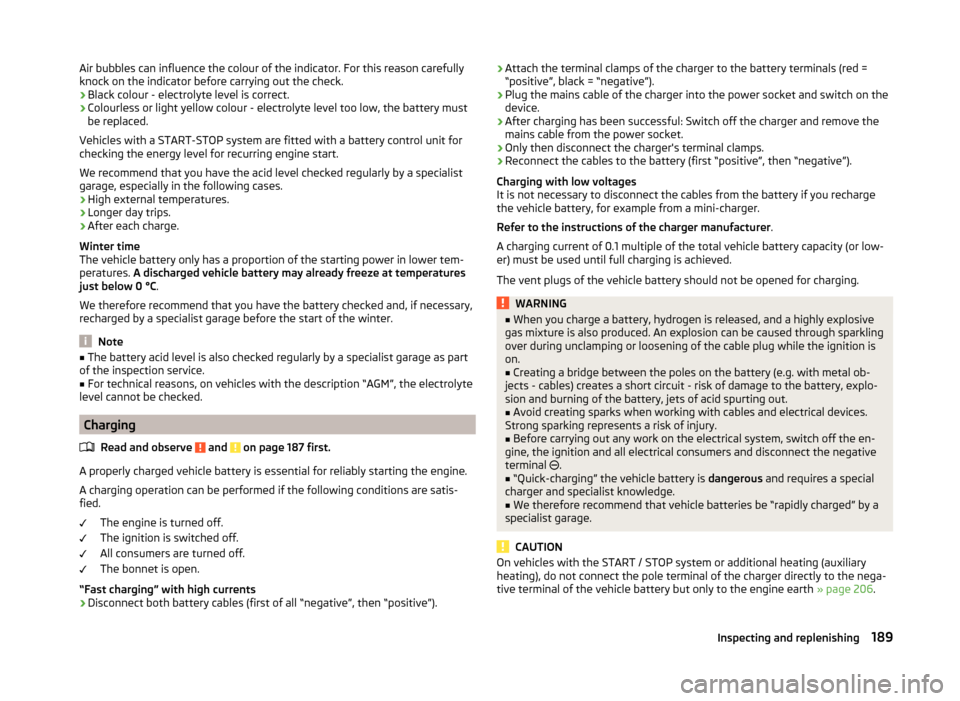
Air bubbles can influence the colour of the indicator. For this reason carefully
knock on the indicator before carrying out the check.
› Black colour - electrolyte level is correct.
› Colourless or light yellow colour - electrolyte level too low, the battery must
be replaced.
Vehicles with a START-STOP system are fitted with a battery control unit for
checking the energy level for recurring engine start.
We recommend that you have the acid level checked regularly by a specialist garage, especially in the following cases.
› High external temperatures.
› Longer day trips.
› After each charge.
Winter time
The vehicle battery only has a proportion of the starting power in lower tem-
peratures. A discharged vehicle battery may already freeze at temperatures
just below 0 °C .
We therefore recommend that you have the battery checked and, if necessary,
recharged by a specialist garage before the start of the winter.
Note
■ The battery acid level is also checked regularly by a specialist garage as part
of the inspection service.■
For technical reasons, on vehicles with the description “AGM”, the electrolyte
level cannot be checked.
Charging
Read and observe
and on page 187 first.
A properly charged vehicle battery is essential for reliably starting the engine.A charging operation can be performed if the following conditions are satis-
fied.
The engine is turned off.
The ignition is switched off.
All consumers are turned off.
The bonnet is open.
“Fast charging” with high currents
›
Disconnect both battery cables (first of all “negative”, then “positive”).
› Attach the terminal clamps of the charger to the battery terminals (red =
“positive”, black = “negative”).›
Plug the mains cable of the charger into the power socket and switch on the
device.
›
After charging has been successful: Switch off the charger and remove the
mains cable from the power socket.
›
Only then disconnect the charger's terminal clamps.
›
Reconnect the cables to the battery (first “positive”, then “negative”).
Charging with low voltages
It is not necessary to disconnect the cables from the battery if you recharge
the vehicle battery, for example from a mini-charger.
Refer to the instructions of the charger manufacturer .
A charging current of 0.1 multiple of the total vehicle battery capacity (or low-
er) must be used until full charging is achieved.
The vent plugs of the vehicle battery should not be opened for charging.
WARNING■ When you charge a battery, hydrogen is released, and a highly explosive
gas mixture is also produced. An explosion can be caused through sparkling
over during unclamping or loosening of the cable plug while the ignition is
on.■
Creating a bridge between the poles on the battery (e.g. with metal ob-
jects - cables) creates a short circuit - risk of damage to the battery, explo-
sion and burning of the battery, jets of acid spurting out.
■
Avoid creating sparks when working with cables and electrical devices.
Strong sparking represents a risk of injury.
■
Before carrying out any work on the electrical system, switch off the en-
gine, the ignition and all electrical consumers and disconnect the negative
terminal
.
■
“Quick-charging” the vehicle battery is dangerous and requires a special
charger and specialist knowledge.
■
We therefore recommend that vehicle batteries be “rapidly charged” by a
specialist garage.
CAUTION
On vehicles with the START / STOP system or additional heating (auxiliary
heating), do not connect the pole terminal of the charger directly to the nega-
tive terminal of the vehicle battery but only to the engine earth » page 206.189Inspecting and replenishing
Page 193 of 248
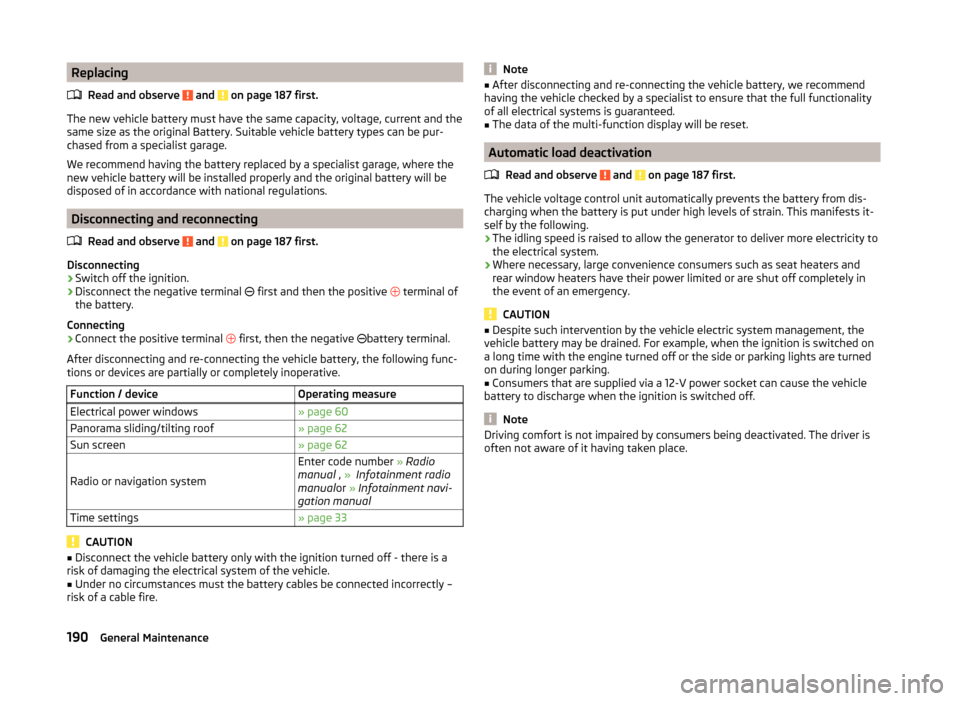
ReplacingRead and observe
and on page 187 first.
The new vehicle battery must have the same capacity, voltage, current and thesame size as the original Battery. Suitable vehicle battery types can be pur-
chased from a specialist garage.
We recommend having the battery replaced by a specialist garage, where the
new vehicle battery will be installed properly and the original battery will be
disposed of in accordance with national regulations.
Disconnecting and reconnecting
Read and observe
and on page 187 first.
Disconnecting
›
Switch off the ignition.
›
Disconnect the negative terminal first and then the positive
terminal of
the battery.
Connecting
›
Connect the positive terminal first, then the negative
battery terminal.
After disconnecting and re-connecting the vehicle battery, the following func-
tions or devices are partially or completely inoperative.
Function / deviceOperating measureElectrical power windows» page 60Panorama sliding/tilting roof» page 62Sun screen» page 62
Radio or navigation system
Enter code number » Radio
manual , » Infotainment radio
manual or » Infotainment navi-
gation manualTime settings» page 33
CAUTION
■ Disconnect the vehicle battery only with the ignition turned off - there is a
risk of damaging the electrical system of the vehicle.■
Under no circumstances must the battery cables be connected incorrectly –
risk of a cable fire.
Note■ After disconnecting and re-connecting the vehicle battery, we recommend
having the vehicle checked by a specialist to ensure that the full functionality
of all electrical systems is guaranteed.■
The data of the multi-function display will be reset.
Automatic load deactivation
Read and observe
and on page 187 first.
The vehicle voltage control unit automatically prevents the battery from dis-
charging when the battery is put under high levels of strain. This manifests it-
self by the following.
› The idling speed is raised to allow the generator to deliver more electricity to
the electrical system.
› Where necessary, large convenience consumers such as seat heaters and
rear window heaters have their power limited or are shut off completely in
the event of an emergency.
CAUTION
■ Despite such intervention by the vehicle electric system management, the
vehicle battery may be drained. For example, when the ignition is switched on
a long time with the engine turned off or the side or parking lights are turned
on during longer parking.■
Consumers that are supplied via a 12-V power socket can cause the vehicle
battery to discharge when the ignition is switched off.
Note
Driving comfort is not impaired by consumers being deactivated. The driver is
often not aware of it having taken place.190General Maintenance
Page 196 of 248
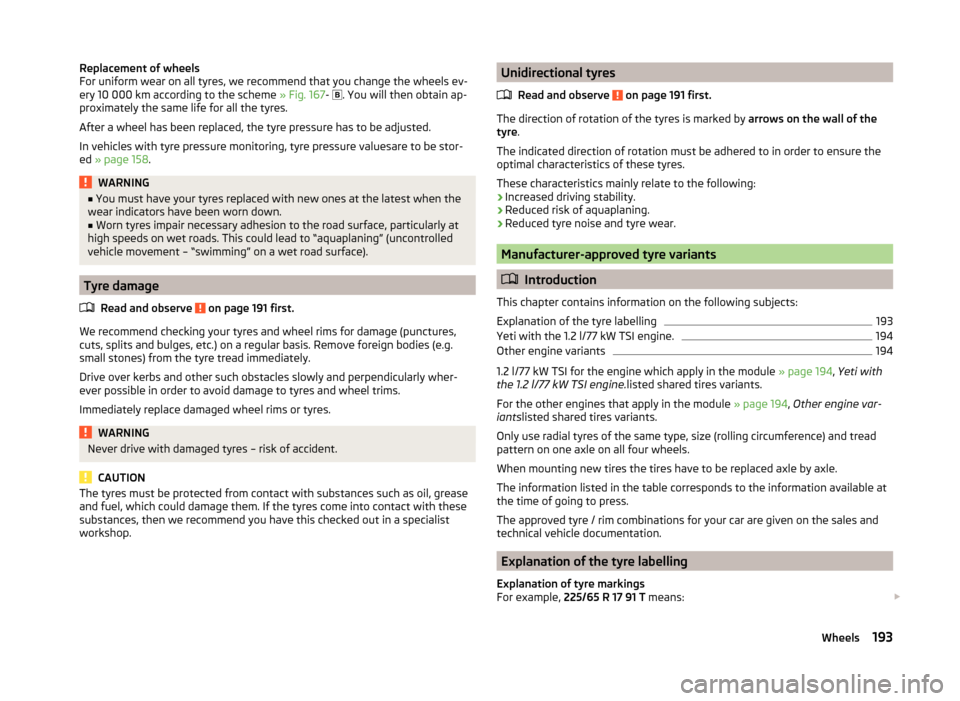
Replacement of wheels
For uniform wear on all tyres, we recommend that you change the wheels ev-
ery 10 000 km according to the scheme » Fig. 167-
. You will then obtain ap-
proximately the same life for all the tyres.
After a wheel has been replaced, the tyre pressure has to be adjusted.
In vehicles with tyre pressure monitoring, tyre pressure valuesare to be stor-
ed » page 158 .WARNING■
You must have your tyres replaced with new ones at the latest when the
wear indicators have been worn down.■
Worn tyres impair necessary adhesion to the road surface, particularly at
high speeds on wet roads. This could lead to “aquaplaning” (uncontrolled vehicle movement – “swimming” on a wet road surface).
Tyre damage
Read and observe
on page 191 first.
We recommend checking your tyres and wheel rims for damage (punctures,
cuts, splits and bulges, etc.) on a regular basis. Remove foreign bodies (e.g.
small stones) from the tyre tread immediately.
Drive over kerbs and other such obstacles slowly and perpendicularly wher-
ever possible in order to avoid damage to tyres and wheel trims.
Immediately replace damaged wheel rims or tyres.
WARNINGNever drive with damaged tyres – risk of accident.
CAUTION
The tyres must be protected from contact with substances such as oil, grease
and fuel, which could damage them. If the tyres come into contact with these
substances, then we recommend you have this checked out in a specialist
workshop.Unidirectional tyres
Read and observe
on page 191 first.
The direction of rotation of the tyres is marked by arrows on the wall of the
tyre .
The indicated direction of rotation must be adhered to in order to ensure the
optimal characteristics of these tyres.
These characteristics mainly relate to the following: › Increased driving stability.
› Reduced risk of aquaplaning.
› Reduced tyre noise and tyre wear.
Manufacturer-approved tyre variants
Introduction
This chapter contains information on the following subjects:
Explanation of the tyre labelling
193
Yeti with the 1.2 l/77 kW TSI engine.
194
Other engine variants
194
1.2 l/77 kW TSI for the engine which apply in the module » page 194, Yeti with
the 1.2 l/77 kW TSI engine. listed shared tires variants.
For the other engines that apply in the module » page 194, Other engine var-
iants listed shared tires variants.
Only use radial tyres of the same type, size (rolling circumference) and tread
pattern on one axle on all four wheels.
When mounting new tires the tires have to be replaced axle by axle.
The information listed in the table corresponds to the information available at the time of going to press.
The approved tyre / rim combinations for your car are given on the sales and
technical vehicle documentation.
Explanation of the tyre labelling
Explanation of tyre markings
For example, 225/65 R 17 91 T means:
193Wheels
Page 208 of 248

Preparations for using the breakdown kitRead and observe
on page 204 first.
The following preparatory work must be carried out before using the puncture
repair kit.
›
Switch off the engine.
›
Engage 1st gear or place the selector lever of the automatic transmission in
the P-position .
›
Firmly apply the handbrake.
›
Check that you can carry out the repairs with the breakdown kit » page 203.
›
Uncouple any trailers.
›
Remove the breakdown kit from the boot.
›
Stick the sticker
1
» Fig. 178 on page 204 on the dashboard in the driver's
field of view.
›
Unscrew the valve cap.
›
Use the valve remover
2
to unscrew the valve core and place it on a clean
surface (rag, paper, etc.).
Sealing and inflating the tyre
Read and observe
on page 204 first.
Sealing
›
Forcefully shake the tyre inflater bottle
10
» Fig. 178 on page 204 back and
forth several times.
›
Firmly screw the inflation hose
3
onto the tyre inflator bottle
10
in a clock-
wise direction. The film on the cap is pierced automatically.
›
Remove the plug from the inflation hose
3
and plug the open end fully onto
the tyre valve.
›
Hold the bottle
10
with the bottom facing upwards and fill all of the sealing
agent from the tyre inflator bottle into the tyre.
›
Remove the empty tyre inflator bottle from the valve.
›
Screw the valve core back into the tyre valve using the valve remover
2
.
Inflating
›
Screw the air compressor tyre inflation hose
8
» Fig. 178 on page 204 firmly
onto the tyre valve.
›
Check that the air release valve
6
is closed.
›
Start the engine and run it in idle.
›
Plug the connector
4
into 12 Volt socket » page 90.
›
Switch on the air compressor with the ON and OFF switch
9
.
›Allow the air compressor to run until a pressure of 2.0 - 2.5 bar is achieved.
Maximum run time of 8 minutes » .›
Switch off the air compressor.
›
If you cannot reach an air pressure of 2.0 – 2.5 bar, unscrew the tyre inflation
hose
8
from the tyre valve.
›
Drive the vehicle 10 metres forwards or backwards to allow the sealing agent
to “distribute” in the tyre.
›
Firmly screw the tyre inflation hose
8
back onto the tyre valve and repeat
the inflation process.
›
If you cannot reach the required tyre inflation pressure here either, this
means the tyre has sustained too much damage. You cannot seal with tyre with the breakdown kit »
.
›
Switch off the air compressor.
›
Remove the tyre inflation hose
8
from the tyre valve.
Once a tyre inflation pressure of 2.0 – 2.5 bar is achieved, continue the journey
at a maximum speed of 80 km/h (50 mph).
WARNING■ If you cannot inflate the tyre to at least 2.0 bar, this means the damage
sustained was too serious. The sealing agent cannot be used to seal the
tyre.
Do not drive the vehicle. Seek help from a specialist garage.■
The tyre inflation hose and air compressor may get hot as the tyre is be-
ing inflated – risk of burning.
CAUTION
Switch off the air compressor after running 8 minutes at the latest – risk of
overheating! Allow the air compressor to cool a few minutes before switching
it on again.
Notes for driving with repaired tyres
Read and observe
on page 204 first.
The inflation pressure of the repaired tyre must be checked after driving for 10
minutes.
If the tyre inflation pressure is 1.3 bar or less
›
Do not drive the vehicle! You cannot properly seal with tyre with the
breakdown kit.
If the tyre inflation pressure is 1.3 bar or more
›
Set the tyre pressure to the correct value.
205Emergency equipment and self-help
Page 220 of 248
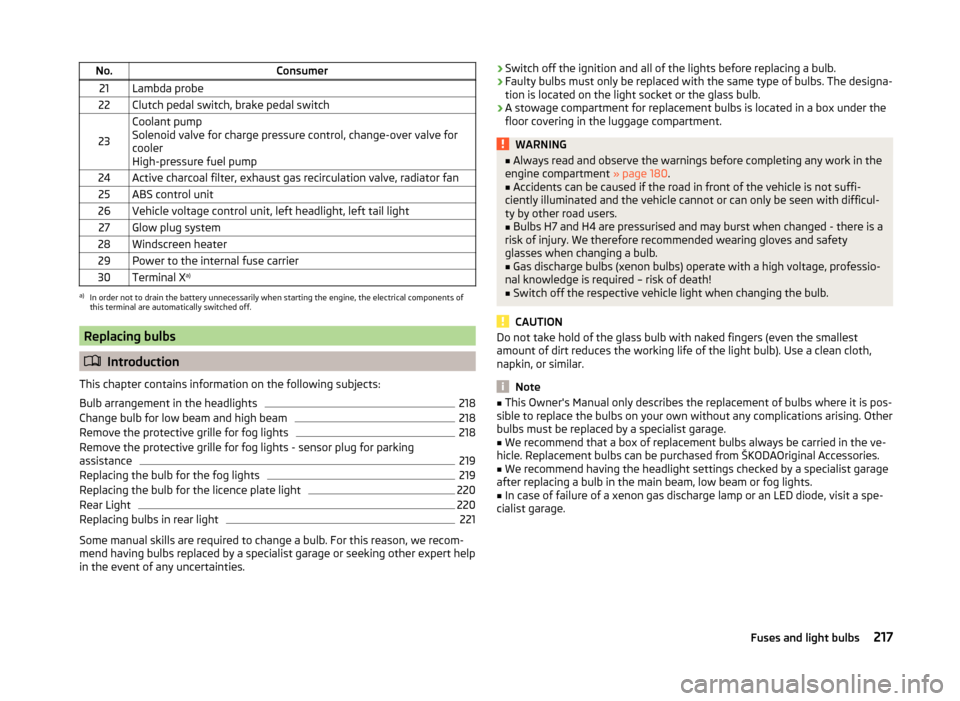
No.Consumer21Lambda probe22Clutch pedal switch, brake pedal switch
23
Coolant pump
Solenoid valve for charge pressure control, change-over valve for
cooler
High-pressure fuel pump24Active charcoal filter, exhaust gas recirculation valve, radiator fan25ABS control unit26Vehicle voltage control unit, left headlight, left tail light27Glow plug system28Windscreen heater29Power to the internal fuse carrier30Terminal X a)a)
In order not to drain the battery unnecessarily when starting the engine, the electrical components of
this terminal are automatically switched off.
Replacing bulbs
Introduction
This chapter contains information on the following subjects:
Bulb arrangement in the headlights
218
Change bulb for low beam and high beam
218
Remove the protective grille for fog lights
218
Remove the protective grille for fog lights - sensor plug for parking
assistance
219
Replacing the bulb for the fog lights
219
Replacing the bulb for the licence plate light
220
Rear Light
220
Replacing bulbs in rear light
221
Some manual skills are required to change a bulb. For this reason, we recom-
mend having bulbs replaced by a specialist garage or seeking other expert help
in the event of any uncertainties.
› Switch off the ignition and all of the lights before replacing a bulb.
› Faulty bulbs must only be replaced with the same type of bulbs. The designa-
tion is located on the light socket or the glass bulb.
› A stowage compartment for replacement bulbs is located in a box under the
floor covering in the luggage compartment.WARNING■ Always read and observe the warnings before completing any work in the
engine compartment » page 180.■
Accidents can be caused if the road in front of the vehicle is not suffi-
ciently illuminated and the vehicle cannot or can only be seen with difficul-
ty by other road users.
■
Bulbs H7 and H4 are pressurised and may burst when changed - there is a
risk of injury. We therefore recommended wearing gloves and safety
glasses when changing a bulb.
■
Gas discharge bulbs (xenon bulbs) operate with a high voltage, professio-
nal knowledge is required – risk of death!
■
Switch off the respective vehicle light when changing the bulb.
CAUTION
Do not take hold of the glass bulb with naked fingers (even the smallest
amount of dirt reduces the working life of the light bulb). Use a clean cloth,
napkin, or similar.
Note
■ This Owner's Manual only describes the replacement of bulbs where it is pos-
sible to replace the bulbs on your own without any complications arising. Other
bulbs must be replaced by a specialist garage.■
We recommend that a box of replacement bulbs always be carried in the ve-
hicle. Replacement bulbs can be purchased from ŠKODAOriginal Accessories.
■
We recommend having the headlight settings checked by a specialist garage
after replacing a bulb in the main beam, low beam or fog lights.
■
In case of failure of a xenon gas discharge lamp or an LED diode, visit a spe-
cialist garage.
217Fuses and light bulbs
Page 235 of 248
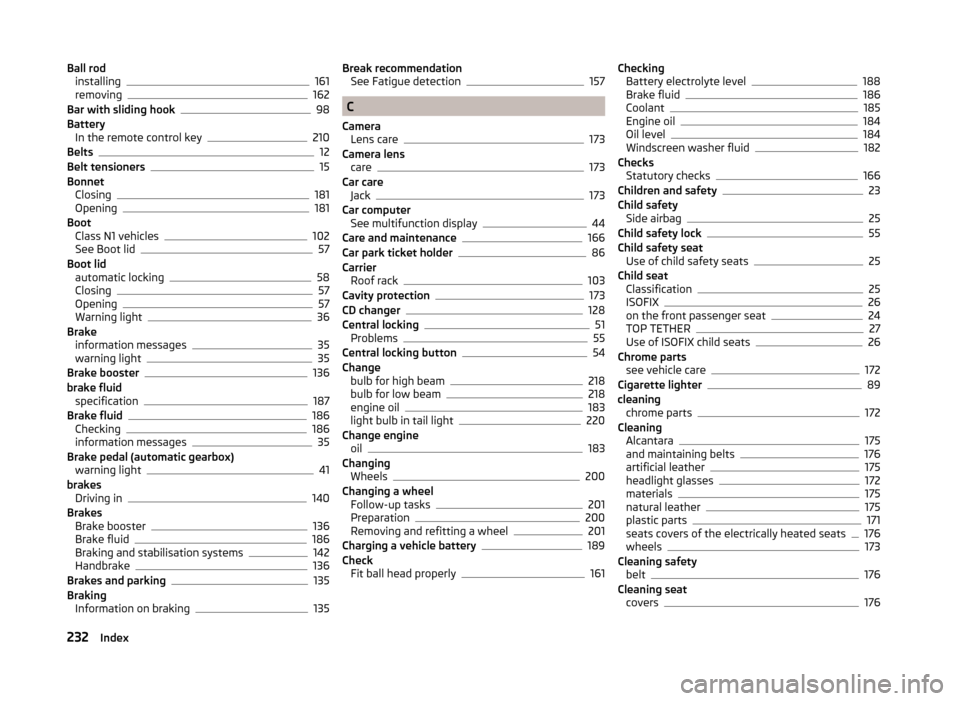
Ball rodinstalling161
removing162
Bar with sliding hook98
Battery In the remote control key
210
Belts12
Belt tensioners15
Bonnet Closing
181
Opening181
Boot Class N1 vehicles
102
See Boot lid57
Boot lid automatic locking
58
Closing57
Opening57
Warning light36
Brake information messages
35
warning light35
Brake booster136
brake fluid specification
187
Brake fluid186
Checking186
information messages35
Brake pedal (automatic gearbox) warning light
41
brakes Driving in
140
Brakes Brake booster
136
Brake fluid186
Braking and stabilisation systems142
Handbrake136
Brakes and parking135
Braking Information on braking
135
Break recommendationSee Fatigue detection157
C
Camera Lens care
173
Camera lens care
173
Car care Jack
173
Car computer See multifunction display
44
Care and maintenance166
Car park ticket holder86
Carrier Roof rack
103
Cavity protection173
CD changer128
Central locking51
Problems55
Central locking button54
Change bulb for high beam
218
bulb for low beam218
engine oil183
light bulb in tail light220
Change engine oil
183
Changing Wheels
200
Changing a wheel Follow-up tasks
201
Preparation200
Removing and refitting a wheel201
Charging a vehicle battery189
Check Fit ball head properly
161
CheckingBattery electrolyte level188
Brake fluid186
Coolant185
Engine oil184
Oil level184
Windscreen washer fluid182
Checks Statutory checks
166
Children and safety23
Child safety Side airbag
25
Child safety lock55
Child safety seat Use of child safety seats
25
Child seat Classification
25
ISOFIX26
on the front passenger seat24
TOP TETHER27
Use of ISOFIX child seats26
Chrome parts see vehicle care
172
Cigarette lighter89
cleaning chrome parts
172
Cleaning Alcantara
175
and maintaining belts176
artificial leather175
headlight glasses172
materials175
natural leather175
plastic parts171
seats covers of the electrically heated seats176
wheels173
Cleaning safety belt
176
Cleaning seat covers
176
232Index
Page 237 of 248
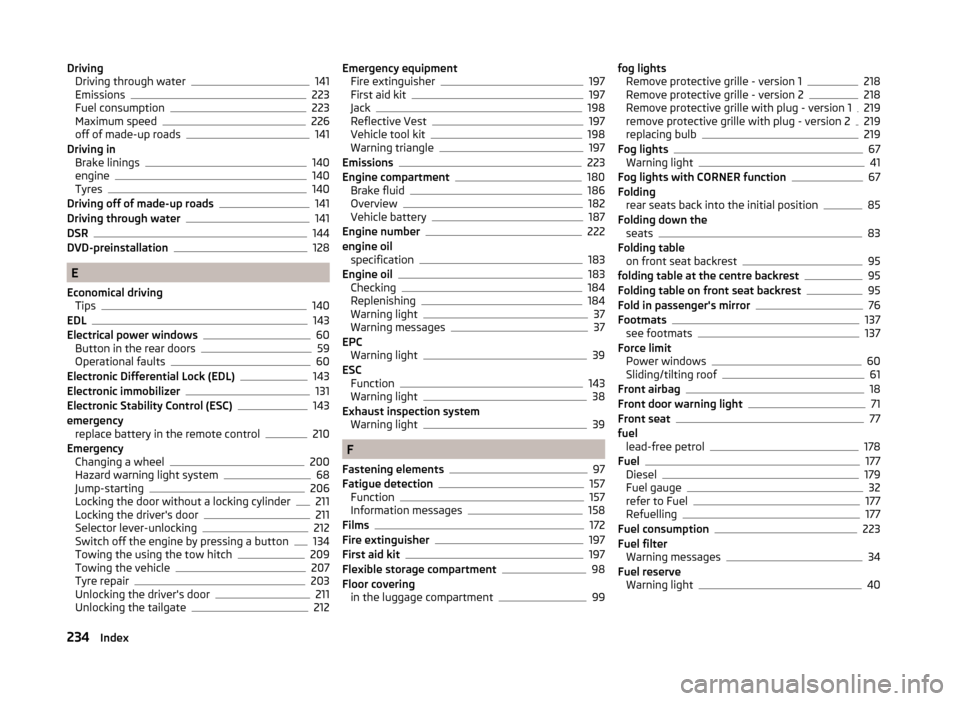
DrivingDriving through water141
Emissions223
Fuel consumption223
Maximum speed226
off of made-up roads141
Driving in Brake linings
140
engine140
Tyres140
Driving off of made-up roads141
Driving through water141
DSR144
DVD-preinstallation128
E
Economical driving Tips
140
EDL143
Electrical power windows60
Button in the rear doors59
Operational faults60
Electronic Differential Lock (EDL)143
Electronic immobilizer131
Electronic Stability Control (ESC)143
emergency replace battery in the remote control
210
Emergency Changing a wheel
200
Hazard warning light system68
Jump-starting206
Locking the door without a locking cylinder211
Locking the driver's door211
Selector lever-unlocking212
Switch off the engine by pressing a button134
Towing the using the tow hitch209
Towing the vehicle207
Tyre repair203
Unlocking the driver's door211
Unlocking the tailgate212
Emergency equipment Fire extinguisher197
First aid kit197
Jack198
Reflective Vest197
Vehicle tool kit198
Warning triangle197
Emissions223
Engine compartment180
Brake fluid186
Overview182
Vehicle battery187
Engine number222
engine oil specification
183
Engine oil183
Checking184
Replenishing184
Warning light37
Warning messages37
EPC Warning light
39
ESC Function
143
Warning light38
Exhaust inspection system Warning light
39
F
Fastening elements
97
Fatigue detection157
Function157
Information messages158
Films172
Fire extinguisher197
First aid kit197
Flexible storage compartment98
Floor covering in the luggage compartment
99
fog lightsRemove protective grille - version 1218
Remove protective grille - version 2218
Remove protective grille with plug - version 1219
remove protective grille with plug - version 2219
replacing bulb219
Fog lights67
Warning light41
Fog lights with CORNER function67
Folding rear seats back into the initial position
85
Folding down the seats
83
Folding table on front seat backrest
95
folding table at the centre backrest95
Folding table on front seat backrest95
Fold in passenger's mirror76
Footmats137
see footmats137
Force limit Power windows
60
Sliding/tilting roof61
Front airbag18
Front door warning light71
Front seat77
fuel lead-free petrol
178
Fuel177
Diesel179
Fuel gauge32
refer to Fuel177
Refuelling177
Fuel consumption223
Fuel filter Warning messages
34
Fuel reserve Warning light
40
234Index
Page 238 of 248
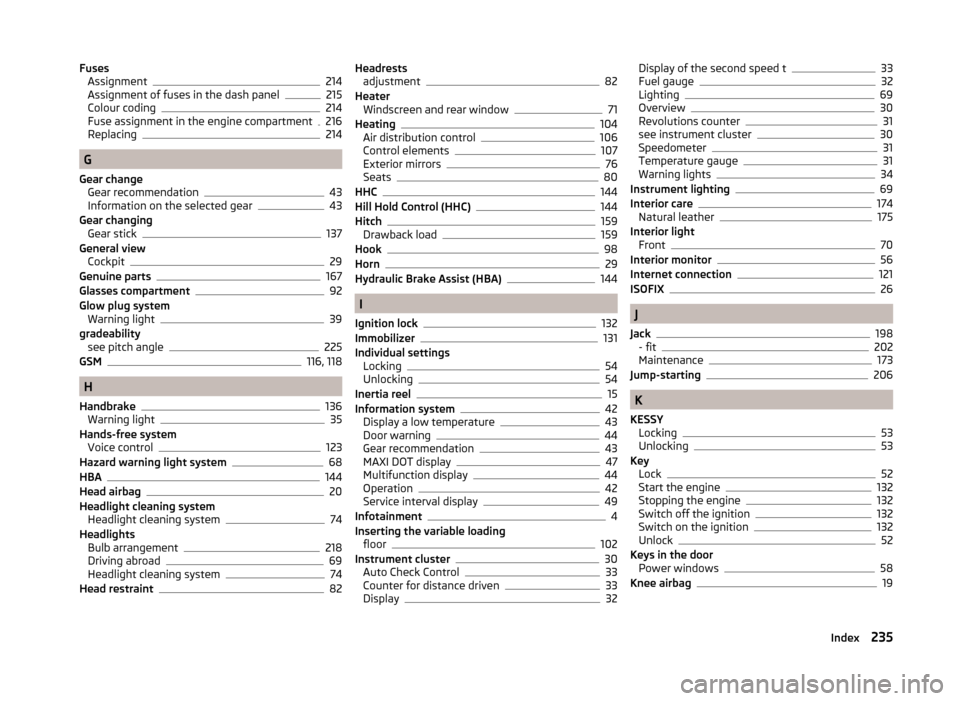
FusesAssignment214
Assignment of fuses in the dash panel215
Colour coding214
Fuse assignment in the engine compartment216
Replacing214
G
Gear change Gear recommendation
43
Information on the selected gear43
Gear changing Gear stick
137
General view Cockpit
29
Genuine parts167
Glasses compartment92
Glow plug system Warning light
39
gradeability see pitch angle
225
GSM116, 118
H
Handbrake
136
Warning light35
Hands-free system Voice control
123
Hazard warning light system68
HBA144
Head airbag20
Headlight cleaning system Headlight cleaning system
74
Headlights Bulb arrangement
218
Driving abroad69
Headlight cleaning system74
Head restraint82
Headrests adjustment82
Heater Windscreen and rear window
71
Heating104
Air distribution control106
Control elements107
Exterior mirrors76
Seats80
HHC144
Hill Hold Control (HHC)144
Hitch159
Drawback load159
Hook98
Horn29
Hydraulic Brake Assist (HBA)144
I
Ignition lock
132
Immobilizer131
Individual settings Locking
54
Unlocking54
Inertia reel15
Information system42
Display a low temperature43
Door warning44
Gear recommendation43
MAXI DOT display47
Multifunction display44
Operation42
Service interval display49
Infotainment4
Inserting the variable loading floor
102
Instrument cluster30
Auto Check Control33
Counter for distance driven33
Display32
Display of the second speed t33
Fuel gauge32
Lighting69
Overview30
Revolutions counter31
see instrument cluster30
Speedometer31
Temperature gauge31
Warning lights34
Instrument lighting69
Interior care174
Natural leather175
Interior light Front
70
Interior monitor56
Internet connection121
ISOFIX26
J
Jack
198
- fit202
Maintenance173
Jump-starting206
K
KESSY Locking
53
Unlocking53
Key Lock
52
Start the engine132
Stopping the engine132
Switch off the ignition132
Switch on the ignition132
Unlock52
Keys in the door Power windows
58
Knee airbag19
235Index